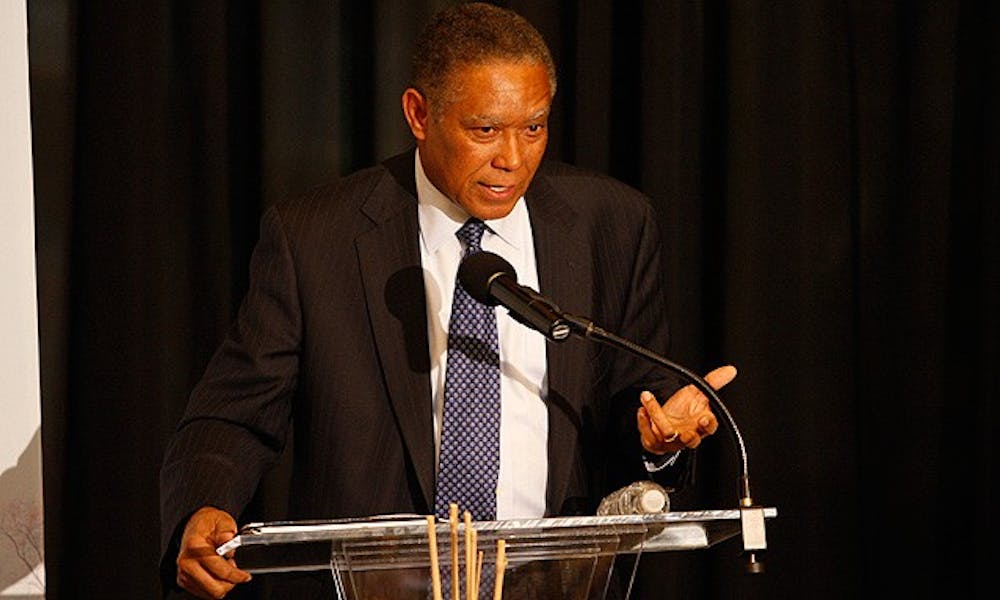The laziness of a late Friday afternoon did not stop a panelist of experts from addressing hard-hitting issues, poverty among them.
A group of scholars and community members gathered at the Sanford School of Public Policy Friday to participate in “To Right These Wrongs: Continuing the work of Terry Sanford,” a symposium that was the final event of the Sanford School Inaugural Series. The event focused on poverty, education and racial inequality, three issues that former Duke President Terry Sanford focused on during his political career as governor of North Carolina. The event, which comes 50 years after Sanford was elected governor, focused on the North Carolina Fund, a series of programs meant to eliminate poverty. Sanford established the fund in 1963.
But for Democratic state Sen. Dan Blue, Law ’73, the symposium’s keynote speaker and the 2010 Terry Sanford distinguished lecturer, Sanford’s legacy goes beyond the North Carolina Fund.
“It was much simpler—being against things doesn’t improve the situation,” said Blue, who is also chair of the Board of Trustees. “The answer comes from looking forward, from creating new ways to attack poverty. It comes from making available economic capital, political capital to poor people and poor communities. The true answers come in working together in fulfilling that meaning of freedom, which Terry Sanford dedicated his life to.”
Blue chronicled Sanford’s political career, a career built on Sanford’s “outrageous ambition and audacious adventure.” Blue specifically spoke of Sanford’s 1960s gubernatorial campaign, during which he spoke against segregation in a contest in which “race questions were raw and on the front burner.” Sanford ran against I. Beverly Lake Sr., whom Blue called a segregationist.
“Sanford won and over the next four years America began to unfold in North Carolina. In many instances we were the pace car... we set new standards,” Blue said. “He spoke of opportunity in terms that no other southern governor had used.”
Other speakers at the symposium discussed how Sanford’s hopes for the state came from his upbringing.
“He really believed in ‘We the people,’” said Thomas Lambeth, a senior fellow at the Z. Smith Reynolds Foundation who worked with Sanford. “He knew that when he grew up in Laurinburg, [N.C.] power did not include all of the people. It’s a story of an effort to make ‘We the people’ truly all of the people.”
The event’s name was based on the newly released book “To Right These Wrongs,” which focuses on the North Carolina Fund and the battle to end poverty and inequality. The book’s authors, who are professors at Duke and the University of North Carolina at Chapel Hill, spoke at the event and hosted a book signing. The event also included a tour of the Sanford School’s new Terry Sanford photo exhibition.
Participants attended three concurrent panel discussions early in the afternoon. The panels, titled “Facing the Achievement Gap from Kindergarten to College,” “From Then to Now: Antipoverty Efforts in North Carolina” and “The Pursuit of Equity in Health, Wealth and Citizenship,” addressed issues that Sanford prioritized in his career. Panelists discussed progress made since the 1960s and mentioned lingering issues.
“We think of poverty as an individual problem but it is really the problem of a place,” said Leslie Winner, executive director of the Z. Smith Reynolds Foundation, who spoke of the need to address both rural and urban poverty. “We need place-based solutions.”
Many of the issues discussed in the panels had some overlap, especially with regard to the need for quality education, something Sanford was a proponent of. Winner said 120 schools in North Carolina are considered low performing, half of which are in the six biggest school districts, all of which have high concentrations of children in poverty.
Among the other panelists was Helen Ladd, the Edgar T. Thompson professor of public policy and professor of economics, who presented her research showing that the more segregated the school, the higher the likelihood that the teachers are not high quality. She added that salary differentials could be used to equalize teacher quality at schools with a large percentage of non-whites but that salary differentials are far less effective at keeping high quality teachers at those schools.
Junior Christina Lee attended the forum on equity in health, wealth and citizenship, and said she enjoyed hearing professor William Darity, Jr.’s presentation about the connection between wealth disparities and race.
“I think it’s really great that they’re doing this,” said Lee, who is in a class taught by Robert Korstad, Kevin D. Gorter professor of public policy and history and a co-author of “To Right These Wrongs.” “I think the whole point of the Sanford School is to continue [Sanford]’s work in the future.”
Blue called on the audience to act upon the ideas Sanford proposed 50 years ago.
“We are failing miserably where Terry would have us succeed,” he said. “Let us choose more progress, not less. Let us choose not to recognize Terry Sanford but to honor him by making it a better state.”
Get The Chronicle straight to your inbox
Signup for our weekly newsletter. Cancel at any time.

